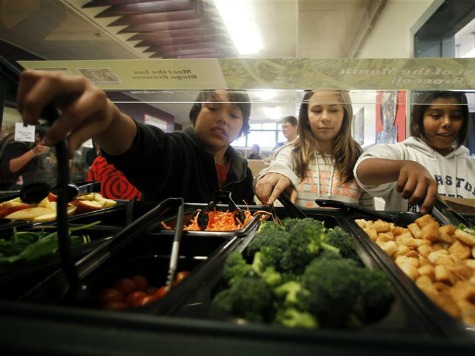MONTANA – The new school year is only a few weeks old, but it’s already becoming clear that the federal government’s new school lunch guidelines are about as popular as the NFL’s replacement referees.
After EAGnews.org published a recent article about how the Obama administration’s new calorie limitations for school lunches are leaving many American students hungry (especially high school athletes), a concerned food service worker from a western Montana school district contacted us with news about how the guidelines are impacting her students.
She only agreed to an interview on the condition of anonymity.
According to our source, the new federal guidelines require vegetables to comprise the largest portion of a student’s lunch, while the entrée is now being treated as a side dish. That means a lot more of the stuff most kids don’t eat and just a tiny portion of the palatable item.
“It’s completely flip-flopped in terms of portion size,” our source says. “I’m appalled at the serving sizes we’re required to give high school students.”
Even though some kids may be leaving the lunch room hungry, the new Obama-imposed rules prohibit students from receiving additional helpings, even when there’s food left over.
“We’re told we cannot serve seconds, that we cannot save leftover food for the next day. We must throw it away,” our source says. “What a waste for hungry kids who aren’t getting enough to eat to begin with.”
She feels especially bad for high school athletes who rapidly burn through calories.
“Two ounces of protein won’t cut it for high school athletes,” she notes.
But the heavy hand of Big Brother is affecting more than the portion sizes at the local school.
While state and federal bureaucrats have always required food service workers keep extensive records of what’s being served, the overall amount of paperwork has exploded with the new Obama administration requirements, according to our source.
“We have to keep an enormous amount of paperwork, about serving sizes, food temperatures, labels, on and on,” our source says. “The new forms are more complex, ask for more information that’s just being duplicated on other forms. (Food service workers) are all collecting the same data for reports that sit in a file drawer and never get looked at.”
Our source believes the new government-required paperwork consumes so much of the employees’ time that it is driving up labor costs for the school district, which serves a low-income community.
“I fail to understand how any of this helps educate children,” she says.
The controversy surrounding the school lunch program stems from “The Healthy Hunger-Free Kids Act,” which was passed by Congress in late 2010.
On Dec. 2, 2010, U.S. Department of Agriculture Secretary Tom Vilsack issued a press release announcing the practical effects of the new law.
Vilsack wrote that the new law will improve “the nutritional quality of all food in schools by providing (the) USDA with the authority to set nutritional standards for all foods sold in schools, including vending machines, the ‘a la carte’ lunch lines, and school stores.”
The federal government is using its new power to impose “calorie maximums for school lunches – 650 calories for elementary-schoolers, 700 for middle-schoolers and 850 for high-schoolers,” reports The Star-Telegram.
Another source – who also requested anonymity – informs EAGnews.org that the federal government is using the power of the purse strings to win school compliance with the new law. Our source says the government only reimburses school districts for student lunches if every tray meets certain nutritional requirements set forth by the USDA.
Rep. Steve King (R – Iowa) has seen enough and wants to repeal the new Obama administration lunch rules.
“For the first time in history, the USDA has set a calorie limit on school lunches,” King said recently, according to The Hill. “The goal of the school lunch program was – and is – to ensure students receive enough nutrition to be healthy and to learn.
“The misguided nanny state, as advanced by Michelle Obama’s ‘Healthy and Hunger-Free Kids Act,’ was interpreted by Secretary Vilsack to be a directive that, because some kids are overweight, he would put every child on a diet. Parents know that their kids deserve all of the healthy and nutritious food they want,” King said.
Vilsack’s plan of slimming down America’s students seems to have a glaring deficiency: If school lunches continue to leave kids hungry, parents will simply pack them a more calorie-rich lunch at home, while older kids who attend schools with open campuses will gravitate to nearby fast food restaurants.
Perhaps Vilsack and other nanny state politicians are already working on the next phase of their plan, which might include checking students’ homemade lunches.
In February, a North Carolina school made national headlines when it was revealed that a lunch inspector told a 4-year-old girl that her homemade turkey sandwich, banana, potato chips and apple juice were unhealthy and that she needed to eat a USDA-approved school lunch.
Fox News reported that when the girl returned home from school with her unopened lunch, it “contained a note from the school saying that her lunch didn’t meet the guidelines and a $1.25 bill for the replacement lunch.”
Nanny state progressives might also follow the lead of New York City Mayor Michael Bloomberg, who has banned large-sized sugary drinks and the use of trans fats, and has imposed strict reductions in the amount of salt contained in packaged and restaurant food, reports CNN.

COMMENTS
Please let us know if you're having issues with commenting.